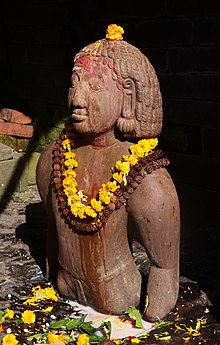This article needs additional citations for verification. (January 2023) |
 Kirati Shamans healing status in Banjhakri Falls Sikkim | |
| Founder | |
|---|---|
| Rulers of Kirat Dynasty | |
| Regions with significant populations | |
| 924,204 (2021) [1] | |
| Unknown | |
| Unknown | |
| Religions | |
| Religious Division of Kiratism (Animism, Shamanism) •Nature worship and Ancestor worship •Satyahangma tradition of Mahaguru Phalgunanda | |
Kirat Mundhum, (Nepali: किरात मुन्धुम) also known as Kiratism, or Kirati Mundhum, is a traditional belief of the Kirati ethnic groups of Nepal, Darjeeling and Sikkim, majorly practiced by Yakkha, Limbu, Sunuwar, Rai, Thami, Jirel, Hayu and Surel peoples in the north-eastern Indian subcontinent.[2] The practice is also known as Kirat Veda,[3][4] Kirat-Ko Veda[5] or Kirat Ko Ved.[6] According to some scholars, such as Tom Woodhatch, it is a blend of shamanism, animism (e.g., ancestor worship of Yuma Sammang/Tagera Ningwaphumang and Paruhang/Sumnima),[7] and Shaivism.[8] It is practiced by about 3.17% of the Nepali population as of 2021.[9]

- ^ "Census Nepal caste-ethnicity results 2021".
- ^ "final layout pdf.p65" (PDF). Archived from the original (PDF) on 2009-09-02. Retrieved 2008-01-22.
- ^ p. 56 Kiratese at a Glance By Gopal Man Tandukar
- ^ p. xxv A Grammar of Limbu By Geordefine sungge van Driem
- ^ Problems of Modern Indian Literature by Statistical Pub. Society: distributor, K. P. Bagchi
- ^ p. 323 Kiratas in Ancient India By G. P. Singh, Dhaneswar Kalita, V Sudarsen, M A Kalam
- ^ "History and Culture of the Kirat" by I.S.Chemjong
- ^ p. 535 Nepal By Tom Woodhatch
- ^ "Archived copy" (PDF). Archived from the original (PDF) on 2013-04-18. Retrieved 2012-11-01.
{{cite web}}: CS1 maint: archived copy as title (link)